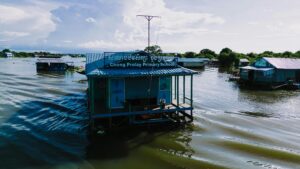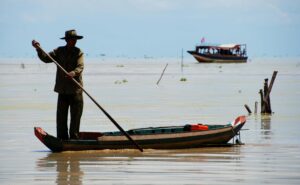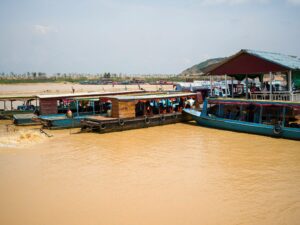Tonle Sap Lake, the largest freshwater lake in Southeast Asia, is one of Cambodia’s most remarkable natural treasures. Known for its unique seasonal fluctuations and vibrant communities, Tonle Sap offers a rare glimpse into the lifeways of the Cambodian people who have adapted to its rhythms for centuries. For travelers seeking an authentic experience, a visit to Tonle Sap is a journey into Cambodia’s natural beauty, biodiversity, and rich cultural heritage. This guide covers everything you need to know about visiting Tonle Sap Lake, from key attractions and floating villages to the best times to visit and travel tips.
Overview of Tonle Sap Lake
Tonle Sap Lake is a UNESCO-designated Biosphere Reserve that spans five Cambodian provinces, making it the most extensive freshwater body in the region. Its name, “Tonle Sap,” means “Great Lake” in Khmer, and its ecological importance cannot be overstated. The lake’s size and depth fluctuate dramatically with the seasons, expanding up to four times its size during the monsoon season and creating a unique ecosystem that sustains diverse plant and animal species, as well as local fishing communities.

Seasonal Changes and the Tonle Sap River Reversal
One of Tonle Sap Lake’s most intriguing features is the seasonal reversal of the Tonle Sap River. During the dry season (November to May), the lake shrinks as water flows from it into the Mekong River. However, during the rainy season (June to October), the Mekong’s rising waters push back, reversing the flow of the Tonle Sap River and flooding the surrounding plains. This natural phenomenon not only increases the lake’s size but also enriches the soil, creating fertile fishing and farming grounds that sustain millions of Cambodians.
Top Attractions Around Tonle Sap Lake
Tonle Sap Lake offers an array of attractions that let visitors experience its natural beauty and the vibrant life it supports. Here are some of the highlights:

Floating Villages
The floating villages of Tonle Sap are one of the lake’s most iconic features. These communities, built on stilts or floating on rafts, move with the lake’s water levels and provide a unique insight into a way of life adapted to the environment. Key floating villages include:
- Kampong Phluk: Located about 16 kilometers from Siem Reap, Kampong Phluk is a stilted village that rises dramatically above the water during the dry season and seems to float during the rainy season. It is less commercialized than other villages, offering a more authentic experience.
- Chong Kneas: The closest floating village to Siem Reap, Chong Kneas is the most popular with tourists. While it offers convenient access, it can be quite crowded, and visitors should expect more tourism-oriented activities.
- Kampong Khleang: This village is further from Siem Reap but is worth the journey for its more traditional vibe and fewer tourists. With houses that reach up to 10 meters above the water, Kampong Khleang provides some of the most striking views.
Bird Watching at Prek Toal Bird Sanctuary
Tonle Sap Lake is a paradise for birdwatchers, especially at the Prek Toal Bird Sanctuary, which is home to numerous rare and endangered species. Located on the lake’s northwest edge, this protected area houses birds like the spot-billed pelican, greater adjutant stork, and painted stork. The best time for bird watching is during the dry season when migratory birds gather here. Guided tours are available to help visitors spot and learn about these unique species.

Tonle Sap Lake Cruises
One of the best ways to explore Tonle Sap Lake is by taking a boat tour. Many tours depart from Siem Reap and offer half-day or full-day excursions to floating villages, local fish farms, crocodile farms, and other points of interest. Sunset cruises are particularly popular, offering stunning views as the sun sets over the lake’s waters.
Local Markets and Fish Farms
Many floating villages feature local markets where visitors can browse traditional Khmer crafts, textiles, and local foods. Some tours also include visits to fish farms and crocodile farms, giving travelers a glimpse of local livelihoods dependent on the lake’s resources.

Best Time to Visit Tonle Sap Lake
The ideal time to visit Tonle Sap Lake depends on the experience you’re looking for:
- Rainy Season (June to October): During this period, the lake reaches its maximum size, and the floating villages truly appear to “float.” This is the best time for scenic boat tours and to witness the unique river reversal phenomenon.
- Dry Season (November to May): As the water recedes, the stilted houses rise above the lake, creating a different but equally fascinating landscape. This is also the best time for birdwatching at Prek Toal and for those who prefer fewer tourists.
Cultural Etiquette and Tips for Visiting
Visiting Tonle Sap’s communities and natural areas requires respect and sensitivity to local culture and the environment. Here are some tips to enhance your visit:
- Dress Respectfully: When visiting villages and temples, wear modest clothing to show respect for local customs.
- Be Mindful of Photography: Always ask permission before photographing people, especially in local communities where privacy is valued.
- Choose Responsible Tours: Many tours are available, but some are more respectful of the local culture and environment than others. Opt for tours that prioritize sustainable practices and contribute to local communities.
- Support Local Economy: Consider buying crafts, food, or souvenirs from local vendors in the floating villages, which helps support their livelihoods.
- Respect the Environment: Tonle Sap is a vital ecosystem, so avoid littering, keep noise levels down, and do not disturb wildlife or plants.
How to Get to Tonle Sap Lake
Tonle Sap Lake is located near Siem Reap, making it easily accessible from the city. Here’s how to reach the lake:
- By Tuk-Tuk: Many tourists choose to take a tuk-tuk from Siem Reap to the lake. It’s a convenient and affordable option, with most drivers offering round-trip services.
- By Tour: Many tours include transportation from Siem Reap to Tonle Sap. These tours are generally organized through hotels, travel agencies, or online booking platforms and can range from a few hours to a full day.
- By Bicycle or Motorbike: Adventurous travelers can rent bicycles or motorbikes from Siem Reap and explore the lake area independently. However, it’s best to visit with a guide if you want to learn more about the local culture and history.
Interesting Facts about Tonle Sap Lake
UNESCO Biosphere Reserve: Tonle Sap was designated as a UNESCO Biosphere Reserve in 1997 due to its unique ecosystem and importance for biodiversity and local communities.
Largest Inland Fishery: Tonle Sap is one of the world’s most productive inland fisheries, supplying around 75% of Cambodia’s fish stock and supporting millions of people’s livelihoods.
Changing Landscapes: The lake’s area can expand from about 2,500 square kilometers during the dry season to more than 16,000 square kilometers during the rainy season, making it a dynamic and ever-changing landscape.
Final Thoughts: Exploring the Wonders of Tonle Sap Lake
A visit to Tonle Sap Lake offers a unique blend of natural beauty, cultural discovery, and insight into Cambodia’s traditional way of life. From the floating villages to the breathtaking bird sanctuaries, every part of Tonle Sap reveals something special about the relationship between the Cambodian people and their environment. Whether you’re taking a boat tour through stilted villages, observing rare bird species, or witnessing the lake’s dramatic seasonal changes, Tonle Sap provides an unforgettable experience that captures the spirit of Cambodia.
Make the most of your time at Tonle Sap by planning ahead, respecting local customs, and embracing the opportunity to learn about this extraordinary lake that plays such a central role in the lives of the Cambodian people. As one of Southeast Asia’s natural wonders, Tonle Sap Lake is a destination every visitor to Cambodia should experience.
